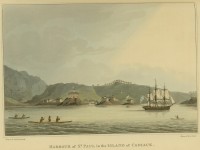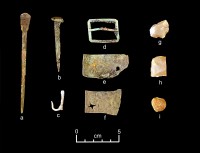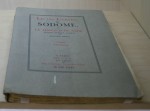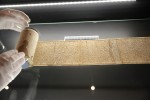One hundred years ago, future etiquette guru Emily Post was given a challenging writing assignment by Collier’s Weekly: travel from New York to San Francisco by automobile in as much style as humanly possible. It was a challenge Emily was enthusiastic to accept, so on April 25th, 1915, Emily Post (riding shotgun), her son Ned (behind the wheel) and her cousin Alice Beadleston (crammed into the back seat with a troubling amount of baggage) set out on a grand adventure in a custom car entirely unsuited to the task.
 In 1915 cross-country motoring was a new trend, the offshoot of a decade of publicity that aimed to lure travelers out west. Railroads, politicians and assorted other commercial interests in the western states had been exhorting Americans to “See Europe if you will, but see America first” since 1906. Keen to get a piece of the $500 million Americans were spending each year in travel to the Old World, they promoted the unique natural wonders of the American west from the Missouri River to the Pacific Ocean in contrast to the inconveniences and expense of travel to Europe. Traveling towards the Pacific rather than across the Atlantic was advertised as a patriotic duty, a means to commune with the “Great Architect” through his greatest works.
In 1915 cross-country motoring was a new trend, the offshoot of a decade of publicity that aimed to lure travelers out west. Railroads, politicians and assorted other commercial interests in the western states had been exhorting Americans to “See Europe if you will, but see America first” since 1906. Keen to get a piece of the $500 million Americans were spending each year in travel to the Old World, they promoted the unique natural wonders of the American west from the Missouri River to the Pacific Ocean in contrast to the inconveniences and expense of travel to Europe. Traveling towards the Pacific rather than across the Atlantic was advertised as a patriotic duty, a means to commune with the “Great Architect” through his greatest works.
Don’t be hypnotized by weird tales of European travel. There is not an attraction in the Old World that cannot be duplicated and discounted by the phenomena of America. Facilities for travel are superior and cheaper at home than anything you may expect in foreign lands. Accommodations for the affluent, and others in more moderate circumstances, await the tourist at every turn of the road. You get what you want, and pay for what you get, and are not hounded to death by a horde of mendicants. You encounter the frank-faced business-like American who intuitively knows your wants and sees that they are supplied. […]
Come by rail, come in your auto-car, come afoot if you like, but come!
The railroads vigorously embraced the “See America First” slogan, encouraging people to enjoy rail voyages to the majestic vistas of the expanding National Park system, the pioneer experience without the pain of pioneering, all of the splendor, none of the survival cannibalism. The Great Northern Railway, whose owner Louis Hill had been instrumental in the creation and funding of Glacier National Park, marketed the park as “America’s Switzerland.” The Northern Pacific Railroad offered summer deals from Chicago to Puget Sound through the “Wonderland” of Yellowstone National Park.
 The most coveted target of the campaign were wealthy Easterners who toured the opulent capitals and resorts of Europe, but they weren’t persuaded that a log cabin stay in Yellowstone was comparable to the en suite bathrooms and Escoffier dinners of the Paris Ritz. It wasn’t until war broke out in 1914 making travel to Europe potentially fatal that the elite turned their eyes west. The next year even more eyes turned west as the Panama-Pacific Exposition in San Francisco and the Panama–California Exposition in San Diego, celebrating the opening of the Panama Canal, drew huge crowds.
The most coveted target of the campaign were wealthy Easterners who toured the opulent capitals and resorts of Europe, but they weren’t persuaded that a log cabin stay in Yellowstone was comparable to the en suite bathrooms and Escoffier dinners of the Paris Ritz. It wasn’t until war broke out in 1914 making travel to Europe potentially fatal that the elite turned their eyes west. The next year even more eyes turned west as the Panama-Pacific Exposition in San Francisco and the Panama–California Exposition in San Diego, celebrating the opening of the Panama Canal, drew huge crowds.
The railroads appealed to people looking for ease and comfort, but automobile travel offered the promise of entirely private, self-directed journeys in the most exciting (and expensive) technology of the day. Enter Mrs. Emily Post. Born Emily Price, she was the daughter of prominent Baltimore architect Bruce Price and mining heiress Josephine Lee Price. Emily was educated by governesses and in private schools before graduating from Miss Graham’s Finishing School in New York City and making her debut in society in 1892. She was the talk of the season and before the year was out, she married wealthy businessman Edwin Post. They went to Europe, of course, for the de rigeur luxurious honeymoon.
 Their marriage fell apart in 1905 when Edwin Post testified in a sensational trial against Col. William D. Mann, a gossip columnist who had attempted to blackmail Post over his showgirl mistress. The distance between them and the public humiliation of the trial drove Emily to divorce him in 1906. With no alimony forthcoming (Edwin had lost much of his fortune in bad investments), she had to work to support herself and her two sons at their fancy private boarding school in Pomfret, Connecticut. Emily took commissions as a decorator and architectural model-builder from her late father’s architect friends and she wrote. She had already had some success as a novelist during the later years of her marriage — her name was spoken in the same breath as Edith Wharton’s in a Washington Post article about working society women — and in 1909 was able to parlay the public’s avid interest in the flood of American heiresses trawling Europe for noble marriage prospects into a popular novel, The Title Market.
Their marriage fell apart in 1905 when Edwin Post testified in a sensational trial against Col. William D. Mann, a gossip columnist who had attempted to blackmail Post over his showgirl mistress. The distance between them and the public humiliation of the trial drove Emily to divorce him in 1906. With no alimony forthcoming (Edwin had lost much of his fortune in bad investments), she had to work to support herself and her two sons at their fancy private boarding school in Pomfret, Connecticut. Emily took commissions as a decorator and architectural model-builder from her late father’s architect friends and she wrote. She had already had some success as a novelist during the later years of her marriage — her name was spoken in the same breath as Edith Wharton’s in a Washington Post article about working society women — and in 1909 was able to parlay the public’s avid interest in the flood of American heiresses trawling Europe for noble marriage prospects into a popular novel, The Title Market.
 Later that year Emily’s mother died in a car accident leaving her daughter a large enough fortune that she wouldn’t have to worry about money ever again. She kept on writing, though, mainly fiction of the “write what you know” variety. It was her background as a wealthy, cultured, widely traveled woman of refined tastes that made her the ideal author for the Collier’s Weekly assignment. Her goal was to see if she could cross the country in the kind of comfort to which her peers were very much accustomed, or at least how far she could get, and to write about the journey in a series of articles.
Later that year Emily’s mother died in a car accident leaving her daughter a large enough fortune that she wouldn’t have to worry about money ever again. She kept on writing, though, mainly fiction of the “write what you know” variety. It was her background as a wealthy, cultured, widely traveled woman of refined tastes that made her the ideal author for the Collier’s Weekly assignment. Her goal was to see if she could cross the country in the kind of comfort to which her peers were very much accustomed, or at least how far she could get, and to write about the journey in a series of articles.
The opening of the first article underscores what a cockamamie scheme people thought it was.
“Of course you are sending your servants ahead by train with your luggage and all that sort of thing,” said an Englishman.
A New York banker answered for me: “Not at all! The best thing is to put them in another machine directly behind, with a good mechanic. Then if you break down the man in the rear and your chauffeur can get to rights in no time. How about your chauffeur? You are sure he is a good one?”
“We are not taking one — nor servants, nor mechanic either.”
“Surely you and your son are not thinking of going alone! Probably he could drive, but who is going to take care of the car?”
“Why, he is!”
Even the nice young man at the Automobile Club recommended she stick to the eastern roads.
“Unfortunately,” he said suavely, “we have not all our information yet, and we seem to be out of our Western maps! But I can recommend some very delightful tours through New England and the Berkshires.”
“That is very interesting, but I am going to San Francisco.”
“Oh, I couldn’t advise that, madam; the New England roads are very much better.”
“But, you see, San Francisco is where I am going. Do you know which route is, if you prefer it, the least bad?”
“Oh, I see.” He looked sorry. “If you must cross the continent, there is the Lincoln Highway!”
“Can you tell me how much work has been done on it?”
“No, I really couldn’t. But it is the best known route.”
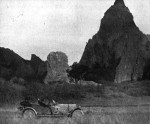 The Lincoln Highway, the first road to cross the continental United States from Times Square in New York to Lincoln Park in San Francisco, had been inaugurated less than two years before that conversation and was very much a work in progress. Unbridged rivers had to be forded and there were significant stretches in the desert west where the car would be the only sleeping facility. Not to mention the difficulty in finding gasoline stations even in towns and cities, never mind once the stretches between developed areas got long.
The Lincoln Highway, the first road to cross the continental United States from Times Square in New York to Lincoln Park in San Francisco, had been inaugurated less than two years before that conversation and was very much a work in progress. Unbridged rivers had to be forded and there were significant stretches in the desert west where the car would be the only sleeping facility. Not to mention the difficulty in finding gasoline stations even in towns and cities, never mind once the stretches between developed areas got long.
Undeterred, Emily and her team hit the road. The search for luxury quickly became desultory as they left the crowded east for the wider open spaces of the midwest and west, but even though Collier’s had told her to turn around the minute she hit discomfort of any kind, Emily kept on trucking through crappy hotels and crappier food and the car getting stuck in the mud outside Chicago (on the Lincoln Highway, no less). The heavy silver picnic set they set out with was shipped back and replaced with a modest ceramic bread basket filled with paper plates. In New Mexico they were mired in a whole  new kind of mud on its “natural roads.” The car’s extra long chassis, imported English motor and skinny wheels were no help in handling the challenges of the terrain. Eventually the car broke down altogether in the Arizona desert. They had to get the car to Los Angeles by freight train before picking up the drive again up the Pacific coast. After 27 days and close to $1,800 spent, they finally made it to San Francisco.
new kind of mud on its “natural roads.” The car’s extra long chassis, imported English motor and skinny wheels were no help in handling the challenges of the terrain. Eventually the car broke down altogether in the Arizona desert. They had to get the car to Los Angeles by freight train before picking up the drive again up the Pacific coast. After 27 days and close to $1,800 spent, they finally made it to San Francisco.
It was far from luxurious, but it was a great adventure and Emily Post lived to tell the tale. The story was published in three parts on September 4th, September 11th and September 18th and was well-received. In 1916, a revised version of the series was published in a book entitled By Motor to the Golden Gate.
